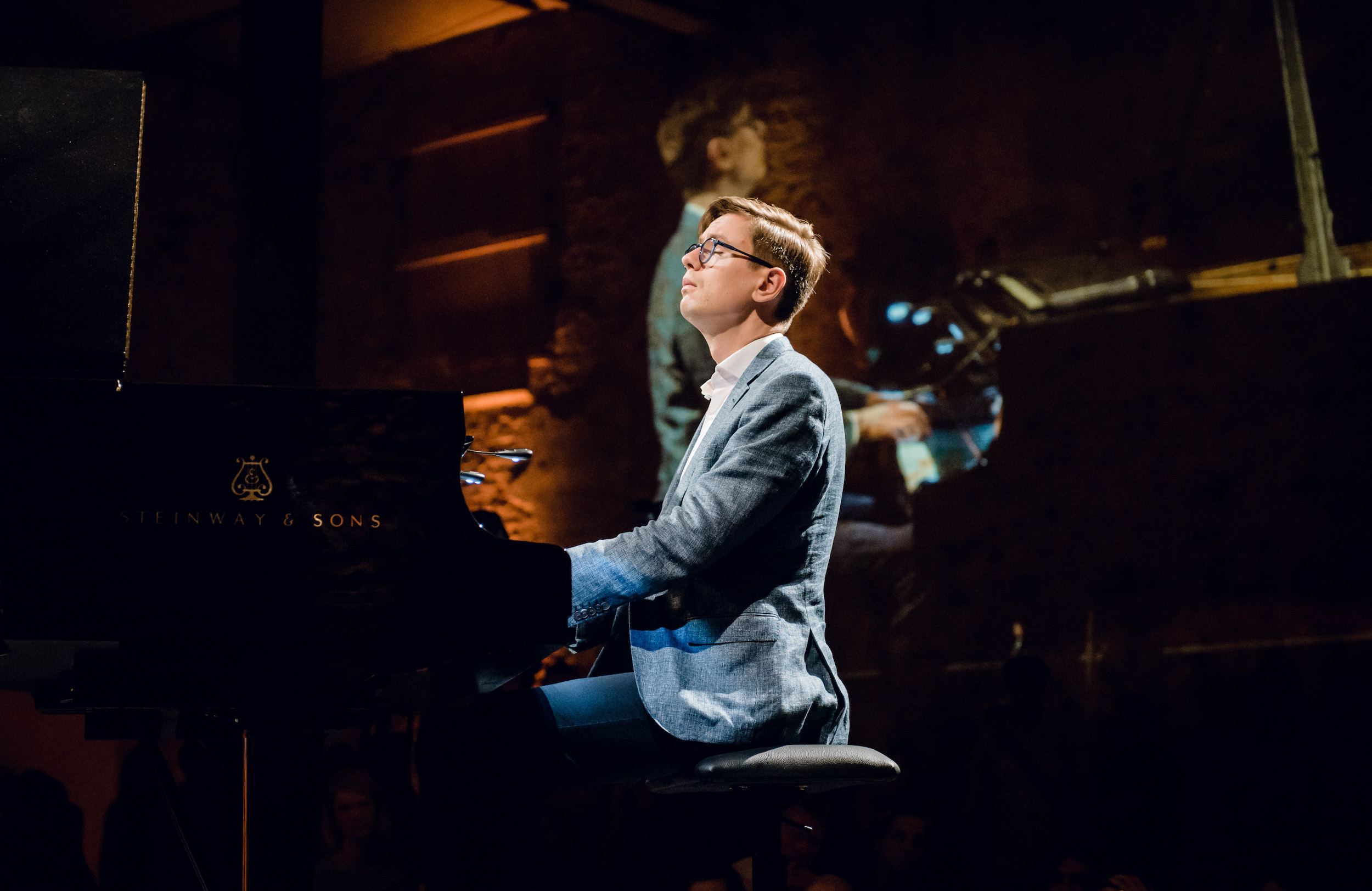As Víkingur Ólafsson walks across the stage in a black tuxedo, the overhead lights somehow make him appear younger than he already does. Even in the serious photos with the turtlenecks and round glasses framing his blue eyes, the 40-year-old Icelandic pianist exhibits a boyishness that betrays the depth of his talent.
Ólafsson approaches the large black piano and sits on the bench in front of a sold-out crowd at Jordan Hall at the New England Conservatory in Boston. I'm part of a room full of shiny dresses, suit jackets, and corduroy sport coats. We’re here to see Ólafsson play Johann Sebastian Bach’s Goldberg Variations, a series of 32 piano compositions that play off the opening aria. It’s roughly 75 minutes of hypnotic music that moves with each motion of a life: from birth to adolescence, first love and heartbreak, through adulthood and old age, eventually returning to where it began. You may have heard the aria while watching Hannibal Lecter kill two security guards and escape from his prison cell in The Silence of the Lambs. In the movie, Anthony Hopkins's character listens to a different recording of the same composition on a tape player.
This concert is a stark difference from the VFW Halls and Worcester Palladium shows I witnessed in my youth. There are no shirtless men in camouflage shorts moshing. There’s certainly no blood. Forget finding a PBR or a ‘Gansett tallboy. And no one will get their grill knocked out of their mouth, which I once witnessed at a Glassjaw show.
While classical music did not influence me from an early age, Ólafsson’s work does something to me today similar to what the music I listened to as a teenager did then. His music does what all great art does: It makes you feel. It can make us rethink our lives, or bring us to understand the world better. It can stay in our memories and connect us to some place and time. Ólafsson’s music does this by bringing new life to old art. He has composed his own music, but what stands out is how he takes the opportunity to create something novel from art created by someone else—as he does with Bach's Variations.
Listening to the Variations made me think of Benjamin Moser’s book, The Upside-Down World: Meetings with the Dutch Masters. In the book, Moser tries to quantify and place the various painters of the Dutch Golden Age, while also looking inward and discovering something about himself in the process. What struck me was a section on the painter Jan Lievens, who had as much skill as Rembrandt but whose paintings lack the thing that Rembrandt has: a way to make a painting affect you as you stand in front of it. Moser concludes that Lievens was a wonderful painter who missed the part where art is personal. Instead, he made plenty of money copying other artists.
“Especially for an artist as naturally talented, it is one thing to follow new styles,” Moser writes. “But the danger of mimicry looms when he follows them without a core of identity. Without that core, the artist floats.”
Ólafsson doesn’t mimic. Instead, he feels the music inside him and radiates it outward.
I first learned of Ólafsson in graduate school thanks to a professor, gray-haired but young and far from the stuffy-professor-in-the-reading-room-by-the-fire type. Over breakfast, he mentioned how he’d started listening to classical music only because to him, other forms had run their course. A few weeks later, I asked him for recommendations.
At the time, I’d started to dabble in classical music thanks to Max Richter, whose song “On the Nature of Daylight” added such depth and despair to the end of the 2016 film Arrival that an already traumatic ending made me weep, alone in my living room. The professor emailed me about Ólafsson, recommending that I start with his 2017 album Philip Glass: Piano Works.
One evening, I found Ólafsson on Spotify and popped in my headphones. The sun set through the windows as I sat on my front porch, preparing to work. But instead of writing, I was stuck. I couldn’t escape the pull of the music. This wasn't an imitation of someone else’s art. Ólafsson was having a conversation with not just Glass, but me. He was reaching through the music and grabbing my spirit.
Imitation can be very profitable. Setting aside the always-present sequels and soft reboots to retain intellectual property rights, a lot of art, even some original work, can feel like it uses reference in substitute of significance. So many "reimaginings" draw from existing creativity but neglect to include any meaning, and they end up hollow and flat. The crucial element that is often ignored is engaging with the original work, rather than the expectation that its mere existence serves as artistic intent. Nostalgia is often used in a cynical way where unaccompanied by sincerity or originality. Play what's familiar rather than making it your own.
And on this unusually warm Saturday night in February, I wait for Ólafsson to perform something Bach published in 1741. His hands hover over the keys. He tilts his head and arches his back as he begins to play.
The night before Ólafsson's concert at Jordan Hall, I met him at his hotel. He told me to come up to his room. He had a living area that was more comfortable to talk in than the lobby, or while wandering the busy streets of Boston when college kids would be out.
Ólafsson looked relaxed for someone who plays some of the most heartfelt music I’d heard. I’d expected some brooding musician, but found a warm and gracious host instead. He had no nerves for his performance the following night. He seemed ready to perform the Goldberg Variations from start to finish. No break, no opener. Just him, a piano, and an audience.
Ólafsson grew up in a different Reykjavík, Iceland. The country's capital in the years it nurtured the 40-year-old pianist had yet to become the travel hub it is today. “I think the kind of seclusion, and the way Iceland worked in those days, was sort of fundamental to my whole being in maybe good and bad ways,” he told me. “But, I think, I’m mostly grateful for it.”
Ólafsson said he lived a typical life and did the normal teenager things: girlfriends, parties, video games. He was able to be himself. His father was an architect and composer; his mother was a musician and piano teacher. Ólafsson's parents didn't come from money, but they purchased a Steinway grand piano and it occupied most of the living room, where his mother taught lessons. Whenever there was a spare moment, Ólafsson said, he sat down and played for as long as he could. It made him happy. He’d play so much that his teacher-mother would tell him to go outside. His love of the instrument did not come from endless lessons, but from having a choice.
“When I played it was because I wanted to play—because I was inspired to play,” Ólafsson said. “In a way, I came from a different background than many of my colleagues who really had a much more systematic upbringing of being created as a pianist by a system. I never had that.”
By the time he was 11, Ólafsson began to take playing the piano seriously. He was already the best player in his age group in the country, but Iceland had a total population in the hundreds of thousands. The walls and boundaries of art hadn’t yet expanded for him. Then, he said, he heard a recording of the Russian pianist Evgeny Kissin playing two “incredible” piano concertos by Frédéric Chopin, and he saw an old photo of the pre-teen whom he thought “played like a god.” His perspective changed: He needed more practice. He started to learn how Kissin played the Chopin pieces. He applied for and attended Juilliard in New York, where he became the student who locked themself in the small practice room with a piano, a bench, and not much else. He found solace in those rooms and spent his time behind those walls. Sometimes he would venture out into the city to see performances at Carnegie Hall. Ólafsson said he would find wealthy patrons leaving early and ask for their tickets, sneaking inside to see some of the best operas and performances in the world.
After six years, Ólafsson finished school and retreated to Europe. He decided he didn’t want to play as many concerts as was expected of him. No recordings. Instead, he wanted to work at home and experiment. He wanted to create “sound worlds." Ólafsson recorded himself relentlessly and became his own critic. He wanted to hear how the piano played off the walls, how he could create. He told me he didn’t want to “always be in the act of doing." He needed to become himself, even if that meant barely making a living. He needed to take everything he’d learned for 20 years and find his voice. He released three albums on his own record label, then in 2017 released his Glass recordings on Universal Music’s German classical label Deutsche Grammophon, which boosted him to relative fame in the classical world.
The Glass recordings are painful and heartfelt. Ólafsson works his way not through how the songs are composed, but how he experiences them, then translates that to the listener. He’s not always giving people what they want, but he is giving himself.
“People want to connect to a person. In the end, that's what brings people together," Ólafsson said. "But also, history's greatest performers in any genre—the only thing they have in common is they are all individualists. They all have their own voice, and you do not mistake it for anybody else's voice.”
In The Upside-Down World, Moser makes the distinction between imitation and interpretation. “The temptation to imitate them is so strong that a young person can reproduce the style without understanding what substance underlies that style and makes it necessary,” he writes in a chapter about Ferdinand Bol and Govert Flinck.
For Ólafsson, the power of Bach isn’t in mimicry, but an understanding of Bach. He views playing Bach’s music something akin to how posterity has treated Shakespeare, whose plays have been chopped and changed since they were first published, interpreted as each subsequent generation needed them. For Ólafsson, Bach requires an artist to try and understand the person as well as the beautiful music because the German composer left no directions on how to play that music.
“You have to try to put yourself into the footsteps of Bach, into his shoes,” Ólafsson said. “And you have to sort of understand, How did you write this music? What's the core? What came before the music on the printed page? What's the process of this music and what is the construction telling me in terms of narrative?”
Those questions may seem fraught, but the search for those answers is what brings Ólafsson’s music to life. He doesn’t look at how other musicians have performed something in the past, or how it’s currently being played. Classical music is a lot of repetition of the greats. There are so many recordings of Bach, Beethoven, Vivaldi, and others—with so many similar and poorly designed album covers—that the search for what will grab you can feel overwhelming. To some degree, classical music requires people like Ólafsson to make it their own. Yes, those are the same notes, but within those notes there is a freedom, in the same way that a writer might create more from a particular poem structure than from free verse.
“Sometimes I feel more creative when I play Bach than when I write my own music,” Ólafsson said. “It's incredible how compositional you can approach this music, and how much you can feel like a co-creator with Bach. He is the very greatest, so I'm not saying I'm co-composing anything with him because he's sort of up there like a solar system. But I am saying when you're playing him, you still have to find that compositional side in yourself and really define the music quite actively.”
This is what's enthralling about Ólafsson, and the Goldberg Variations. Bach’s music can be found in countless movies and commercials that have used his minimal compositions to sell something, but in Ólafsson’s recordings, I stopped and listened. There's freedom inside the structure.
“You can't take a middle-of-the-road approach to Bach, because there is no middle of the road," he said to me. "It's an open space, an open canvas, and you have to paint your picture, which is why I think Bach often makes people feel uncomfortable."
Ólafsson’s fingers touch the keyboard, and for 75 minutes he plays without stopping. He moves through the Goldberg Variations at a pace that feels unsustainable. At times, his body is so contorted that he seems like his head is going to crash into the piano keys.
As I'm seated, my mind is allowed to wander. Ólafsson has played this Bach piece so many times he knows it by heart, but instead of just performing, he begins to move with the music. He’s creating again. He's building something new. The notes are the same, but the feeling and the mood is different. He’s taking the variations somewhere new. This isn’t a pristine recording. Each concert hall is different, and Ólafsson knows that. He embraces the variable and makes the music feel new and alive.
The person sitting next to me has the sheet music on an iPad and follows along as Ólafsson moves from one variation to the next. I close my eyes to keep myself from watching them take notes. I begin to fade in and out. I start to feel the music instead of just hearing it. I feel like I can envision Ólafsson’s life as he plays. I start to see the stages that Bach writes into the structure of the variations.
And then it’s over. Ólafsson stands up and takes a bow. The crowd gives him a standing ovation. He walks off stage. He returns to bow and thank the crowd—once, twice, I lose count.
“There is no encore,” Ólafsson finally says, “because the Goldberg Variations is the encore.”
And yet, people linger. The lights come on. Eventually we file out into the night, different than when we arrived.






